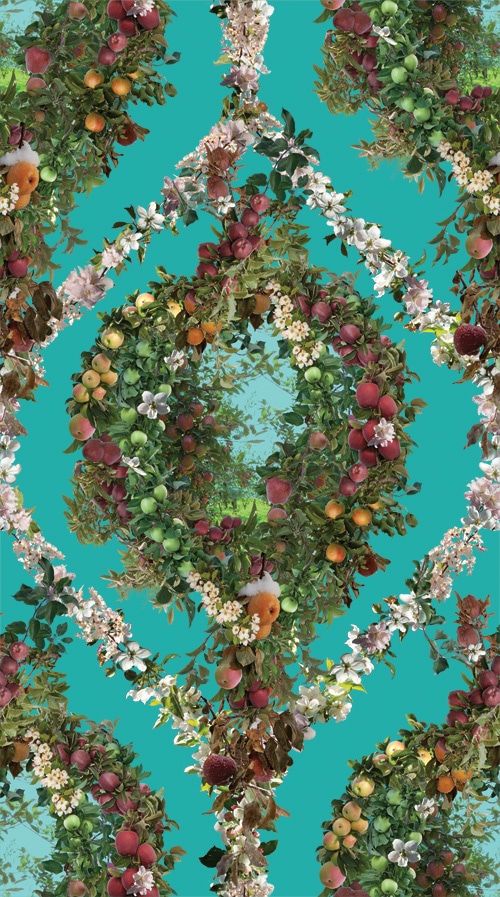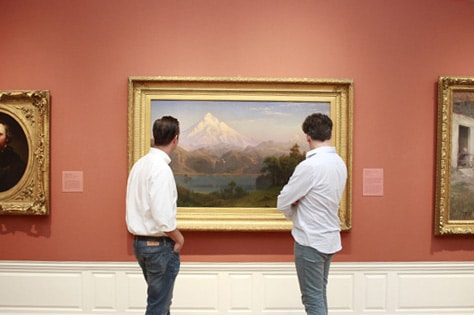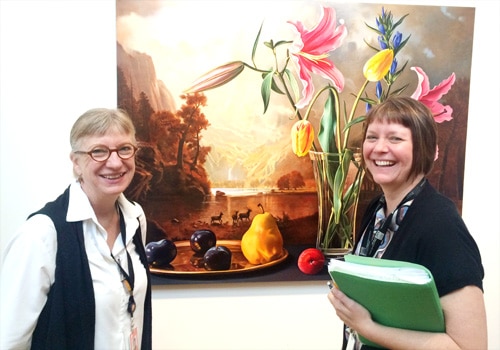PARADISE at Portland Art Museum
Paradise
Fallen Fruit (David Burns and Austin Young)
Join us! Opening day, A Day in Paradise, will feature site specific art works by Oregon based artists and it’s free for everyone! Look here.
Portland Art Museum
OCT 24, 2015 – JAN 17, 2016
“…I was upon the summit of a tall mountain which commands a bewildering prospect of that loved valley… The birds of autumn caroled their soft melodies around, and the blushing flowret bent at the feet of the intruder… Away to the north was the smoke wreathing above the trees which clustered around the lone mission-house and I thought there was an altar to God, and incense from the bosom of the wilderness.”
—Excerpt from A Sketch of the Oregon Territory, or Emigrant’s Guide, Philip L. Edwards, 1842.

Fallen Fruit (David Burns and Austin Young), Apple Wallpaper (Paradise edition), dimensions variable, 2015 This custom designed wallpaper echoes the 19th century and the era of the founding of art museums in the United States.
By the 1850s, the rutted Oregon Trail ferried large numbers of settlers into the heart of the Willamette Valley. A steady diet of florid guidebooks promised a fecund new Eden where everything grew. Oregon came packaged as a vision of “paradise,” ripe with possibility and a symbol of Westward Expansion and Manifest Destiny.
The artist collaborative Fallen Fruit will explore Oregon’s paradisiacal backyard through the lens of Portland Art Museum’s permanent collection. Based in Los Angeles, artists David Allen Burns and Austin Young create site-specific projects using fruit to examine concepts of place, history, and issues of representation often addressing questions of public space.
The apple is a fruit that has come to represent the hearty bounty of the Northwest with deep connections to the landscape and of westward movement. It’s often a symbol of moral questioning and serves as a metaphoric reference to the Garden of Eden. In Paradise, Fallen Fruit will create an eye-popping immersive art installation in the Arlene and Harold Schnitzer Sculpture Court using the Portland Art Museum’s permanent collections to thematically explore concepts of “paradise,” sublime landscape, and the greater Northwest.

David and Austin studying the “anchor” painting, Mount Hood by Albert Bierstadt, 1869 for Paradise.

Bonnie Laing-Malcolmson, the Arlene and Harold Schnitzer Curator of Northwest Art and Stephanie Parrish, Associate Director of Education and Public Programs in front of Floral Arrangement After Bierstadt, Sherrie Wolf, 2003, 2004
Fallen Fruit of Portland
Paradise is part of Fallen Fruit of Portland, a suite of five site-specific projects taking place throughout Portland in October and November 2015. Other Fallen Fruit of Portland projects include Urban Fruit Trails, The Geography of We (a youth curated exhibition at Weiden+Kennedy Gallery), Division of Identification, and the commissioning of eight Oregon-based artist projects. All projects are presented by Caldera and funded by a Creative Heights grant from The Oregon Community Foundation. For more information on the Fallen Fruit of Portland projects or Caldera, please visit here.
About the Portland Art Museum
The seventh oldest museum in the United States, the Portland Art Museum is internationally recognized for its permanent collection and ambitious special exhibitions drawn from the Museum’s holdings and the world’s finest public and private collections. The Museum’s collection of more than 45,000 objects, displayed in 112,000 square feet of galleries, reflects the history of art from ancient times to today. The collection is distinguished for its holdings of arts of the native peoples of North America, English silver, and the graphic arts. An active collecting institution dedicated to preserving great art for the enrichment of future generations, the Museum devotes 90 percent of its galleries to its permanent collection. The Museum’s campus of landmark buildings, a cornerstone of Portland’s cultural district, includes the Jubitz Center for Modern and Contemporary Art, the Gilkey Center for Graphic Arts, the Schnitzer Center for Northwest Art, the Northwest Film Center, and the Confederated Tribes of Grand Ronde Center for Native American Art. With a membership of more than 18,000 households and serving more than 350,000 visitors annually, the Museum is a premier venue for education in the visual arts. For information on exhibitions and programs, call 503-226-2811 or visit portlandartmuseum.org.
